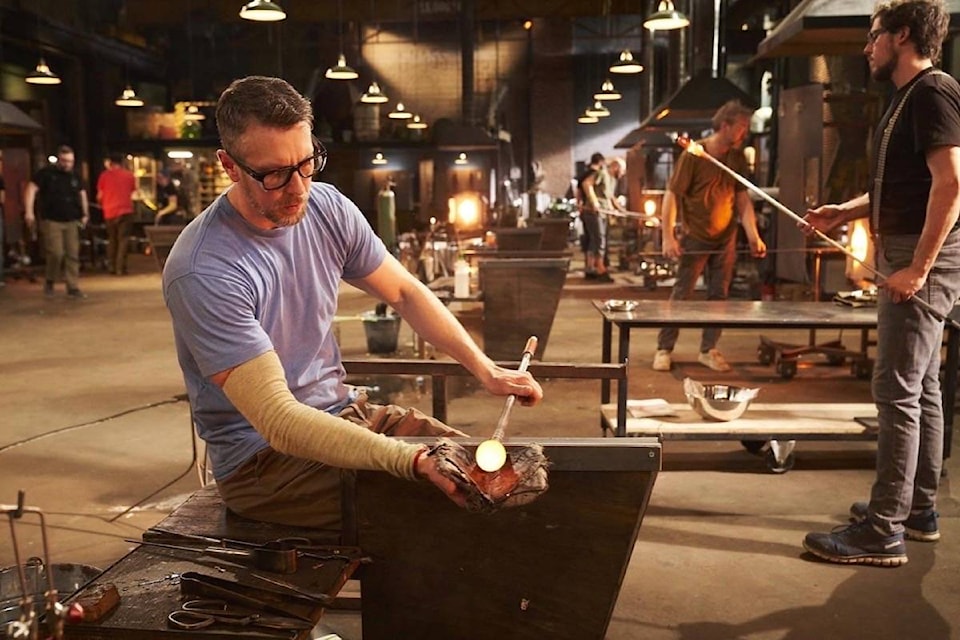TORONTO — Brad Turner is often asked how dangerous his career is. His answer: it’s as risky the person doing it.
As a Toronto-based glass artist and contestant on season 2 of “Blown Away” on Netflix, Turner makes his works through glass blowing, which involves manipulating molten mixtures with torches, stainless steel pipes, and furnaces as hot as 1,300 C.
“It’s like driving: driving is dangerous if you’re a dangerous driver. Glass blowing is dangerous if you’re not paying attention and you’re generally careless,” the Toronto-based Turner said in an interview.
“Yeah, you’ll burn yourself occasionally. But as long as you’re smart and not careless, you’re fine.”
The heat is turned up even more, literally and figuratively, on “Blown Away,” in which glass artists “fight fire with fire” as they compete for the chance to win $60,000 in prizes and the title of “best in blow.”
Executive producer Matt Hornburg says they shot the series in Hamilton in a large industrial warehouse equipped with 10 furnaces as well as reheat ovens known as glory holes and cooling kilns.
At the beginning of season 1 they found the temperatures intense and had to add more air conditioners and create further ventilation in the ceiling.
Safety “is always the number one priority” on set, Hornburg said, noting they have a paramedic on standby at all times and do careful rehearsals so the crew understands the boundaries on set. They “haven’t had any injuries whatsoever.”
“It’s one of those things where sometimes you’re glad you don’t know what you don’t know. I’m sure if we knew what we had to pull off, we may have never tried,” Hornburg, co-founder of Marblemedia, said with a laugh of the time his Toronto-based production company conceived the idea for the show.
“But essentially we created North America’s largest hot shop.”
And they created a critical hit.
Time magazine, for instance, called “Blown Away” “the best new creative contest since RuPaul’s Drag Race.” And the New York Times declared: “It’s oddly low stakes, but all the glass making is extremely rad.”
Netflix doesn’t typically release ratings, but executives have told Marblemedia the series had “really good numbers” when it came to viewers watching until the end, Hornburg said.
Hornburg feels the series struck a chord by being authentic to the art form and simplistic in its execution, with passionate characters who stretch, cut and sculpt flaming-hot glass in weird and wonderful ways. Sometimes the glass shatters, along with egos.
“It was fun in some ways but also really stressful, because it’s not really how any of us work,” Turner said. “As an artist and a glass blower, your process isn’t: you get a project brief, think about it for, like, absolutely no amount of time and try to make it in five hours…. So it was a big adjustment for all of us.”
Hornburg said there was initially some skepticism about the series in the glass blowing community.
“It’s a tight-knit community — one that, like any community, is very proud of what they do, as they should be, and probably very skeptical of: ‘What does a reality show look like with glass blowing?’” he said. “And we didn’t have any examples we could point to, so there was a lot of trust that we had to build with them.”
The company assured them it was “meant to be a celebration of the art form and the best of the best,” Hornburg said.
“And certainly, we feel that we’ve achieved that, because the feedback from the glass community has been very positive.”
The Corning Museum of Glass in New York State is a partner of the series, offering a residency there as the grand prize.
Experts from Sheridan College’s Faculty of Animation, Art and Design in Ontario have also worked with the production and helped create the show’s glass blowing hot shop.
Hornburg said the series is also providing “tremendous exposure” to the artists, some of whom have gone on to do commercial work after the show.
Turner is the lone Canadian contestant in the recently launched second season, which was shot just before the COVID-19 pandemic hit and has a total of 10 competitors who are largely based in the U.S.
He got into glass blowing after taking kinesiology in university, and then switching gears to study graphic design and illustration.
“Glass has this combination of a physical component and a creative component that for me was kind of the best of both worlds,” he said.
He’s happy “Blown Away” is helping people realize the craftsmanship that goes into the physically demanding pursuit, in which an artist can’t pause on a piece until it’s ready to be cooled.
“It’s one of those things people don’t really know about, it’s pretty obscure,” he said. “If you don’t see it, you can’t understand what’s going on. The process can’t be explained through words.”
This report by The Canadian Press was first published Feb. 1, 2021.
